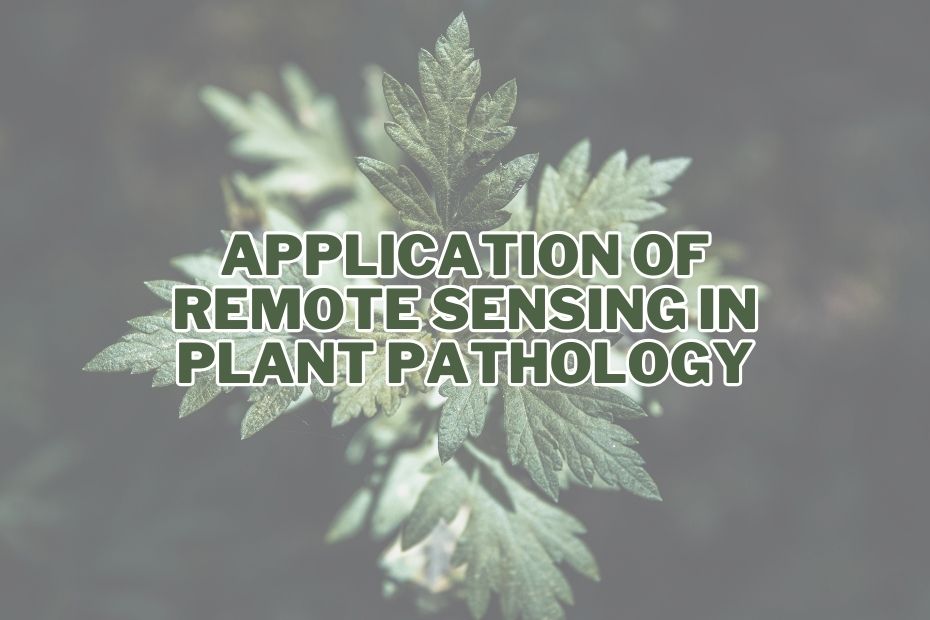In the world of agriculture, staying one step ahead of diseases and ensuring optimal crop health is crucial for food security and economic sustainability. Traditional methods of plant disease detection and management often fall short, leading to crop loss and resource inefficiency. Enter remote sensing, a cutting-edge technology that has transformed the field of plant pathology. In this article, we’ll explore the diverse application of remote sensing in plant pathology, ranging from early disease detection to post-harvest monitoring.
Remote sensing in plant pathology revolutionizes disease detection. It employs satellite and drone technology to monitor crop health, identifying issues like fungal infections or nutrient deficiencies. This proactive approach enhances crop management, minimizing losses, and ensuring sustainable agriculture.
Application of Remote Sensing In Plant Pathology
By employing various remote sensing techniques such as satellite imagery, drones, and hyperspectral imaging, researchers and agriculturists can detect, diagnose, and mitigate plant diseases with unprecedented precision.
1. Early Disease Detection
Remote sensing plays a pivotal role in early disease detection. By utilizing the Normalized Difference Vegetation Index (NDVI), experts can identify subtle changes in plant health that may indicate the presence of disease. These early warnings enable farmers to take prompt action, preventing extensive crop damage.
2. Disease Severity Assessment
Assessing the severity of plant diseases accurately is vital for effective management. Remote sensing tools provide quantitative data on disease severity, enabling precise decisions on treatment strategies. By monitoring changes in plant reflectance and other indicators, pathologists can gauge the extent of disease spread and its impact on crop health.
3. Precision Disease Management
Precision agriculture is the future, and remote sensing plays a pivotal role in it. With detailed spatial data, farmers can implement targeted disease management strategies. This includes the precise application of pesticides and fungicides only where needed, reducing environmental impact and lowering production costs.
4. Yield Estimation
Accurate yield estimation is essential for crop planning and market forecasting. Remote sensing technology can help predict crop yields by monitoring plant health throughout the growing season. By analyzing data on plant growth and vitality, farmers and policymakers can make informed decisions about resource allocation and distribution.
5. Soil Health Monitoring
Healthy soil is the foundation of robust crop growth. Remote sensing extends its capabilities to assess soil health parameters. It can measure soil moisture, nutrient content, and pH levels, providing valuable insights for optimizing fertilization and irrigation practices.
6. Climate Impact Analysis
Climate change poses significant challenges to agriculture. Remote sensing allows for the monitoring of climate-related changes such as temperature, precipitation, and humidity. These data help farmers adapt to shifting weather patterns and make informed decisions about crop selection and planting times.
7. Fungal Disease Identification
Fungal diseases can devastate crops if not promptly identified and managed. Remote sensing technologies, including hyperspectral imaging, can detect specific spectral signatures associated with fungal infections. This allows for targeted disease identification and treatment.
8. Bacterial Disease Identification
Like fungal diseases, bacterial infections can harm crops. Remote sensing aids in identifying bacterial diseases by detecting unique spectral patterns associated with bacterial pathogens. This early detection facilitates timely intervention.
9. Viral Disease Identification
Remote sensing’s hyperspectral capabilities extend to viral disease identification. By analyzing the spectral signatures of infected plants, researchers and farmers can identify viral outbreaks swiftly, preventing further spread.
10. Weed Detection and Management
Weeds compete with crops for resources and can significantly reduce yields. Remote sensing technology can distinguish between crops and weeds, enabling precise herbicide application. This targeted approach minimizes herbicide use and reduces environmental impact.
11. Nutrient Deficiency Diagnosis
Nutrient deficiencies can stunt plant growth and reduce yield. Remote sensing can detect early signs of nutrient imbalances by analyzing leaf reflectance patterns. This information guides farmers in adjusting their fertilization practices for optimal crop nutrition.
12. Post-Harvest Disease Monitoring
Even after harvest, the risk of disease persists. Remote sensing aids in post-harvest disease monitoring by assessing storage conditions and tracking changes in crop quality. This helps prevent post-harvest losses and ensures the delivery of high-quality produce to consumers.
Conclusion:
In conclusion, remote sensing technology has revolutionized plant pathology and agriculture as a whole. Its applications range from early disease detection to precision management, yield estimation, and environmental sustainability. By harnessing the power of remote sensing, farmers and researchers can work together to safeguard crop health, increase productivity, and meet the ever-growing global demand for food.
FAQs: Application of Remote Sensing In Plant Pathology
How does remote sensing assist in weed management?
Remote sensing technology can distinguish between crops and weeds, enabling precise herbicide application. This targeted approach minimizes herbicide use and reduces the competition between crops and weeds.
Can remote sensing technology be used for post-harvest monitoring?
Yes, remote sensing can be used for post-harvest monitoring by assessing storage conditions and tracking changes in crop quality.
How does remote sensing help in early disease detection?
Remote sensing can detect subtle changes in plant health that are not visible to the naked eye. By analyzing these changes, it can provide early warnings of potential disease outbreaks in crops.
